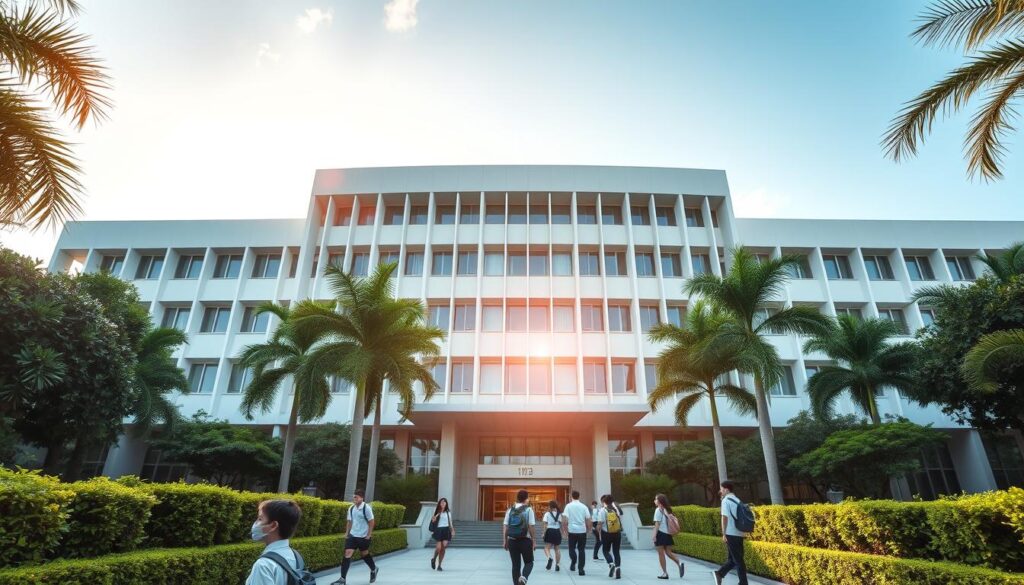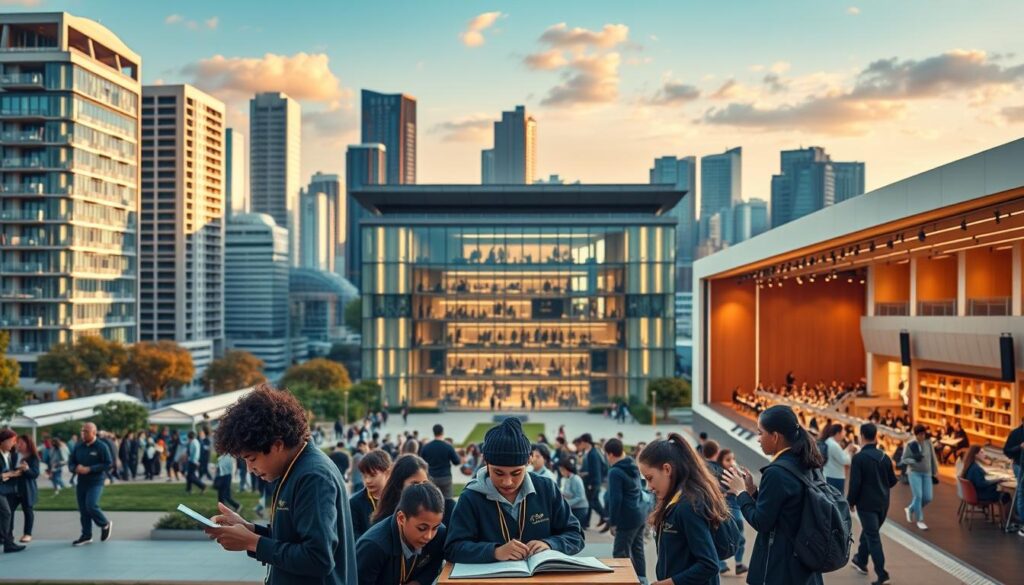Singapore stands out as a global leader in education, consistently ranking high in OECD/PISA assessments. The country offers diverse learning environments, from public institutions to renowned international school networks. This variety ensures families can find the right fit for their child’s needs.
Choosing the right institution involves weighing factors like curriculum, costs, and admission competitiveness. Many international school options provide hybrid programs, blending local and global teaching methods. This flexibility appeals to parents seeking a balanced approach.
Our guide covers over 10 categories of institutions, helping families make informed decisions. Whether prioritizing academic excellence or cultural diversity, Singapore’s system delivers quality choices.
Key Takeaways
- Singapore ranks among the world’s top education systems.
- Public and private institutions offer distinct advantages.
- Admission processes can be highly competitive.
- Hybrid curricula combine local and global learning methods.
- This guide simplifies decision-making for families.
Introduction to Singapore’s Education System
Singapore’s reputation for academic excellence is built on a well-structured and adaptable system. Recognized globally for its high standards, the country tailors learning pathways to suit diverse student needs. Whether through public institutions or international schools, the focus remains on holistic development and future readiness.
Why Singapore’s System Excels Globally
Ranked #1 in the OECD for education quality, Singapore emphasizes critical thinking and problem-solving. The Ministry of Education outlines rigorous benchmarks, ensuring students master core competencies early. This approach prepares them for competitive secondary and post-secondary opportunities.
Central to this success is the Primary School Leaving Examination (PSLE). This assessment determines secondary school placement, aligning students with streams like Express, Normal Academic, or Normal Technical. Subject-Based Banding (SBB) further personalizes learning, letting pupils tackle subjects at varying difficulty levels.
Navigating the Educational Pathways
Singapore’s framework spans six years of primary education, followed by four to six secondary years. The Integrated Programme (IP) gains traction for its direct route to A-Levels, bypassing O-Level exams. Families often weigh IP’s intensity against traditional streams or international school curricula like IB or AP.
Public and private institutions cater to distinct priorities. Local schools singapore offers affordability and cultural immersion, while international schools provide globally recognized diplomas. Both pathways underscore Singapore’s commitment to nurturing adaptable, skilled students.
How We Selected the Best Schools in Singapore
Our evaluation process combines hard data with qualitative assessments for balanced results. We analyzed academic performance, holistic development programs, and admission competitiveness to identify standout options.
Key Criteria for Evaluation
Academic rigor topped our list, with PSLE cut-offs and subject-based banding as primary metrics. However, we equally valued:
- Co-curricular achievements (sports, arts, leadership)
- Teacher-to-student ratios
- International curriculum compatibility
Understanding PSLE Scores and Streams
The 2023 PSLE thresholds highlight intense competition. Integrated Programme (IP) schools demand 6–9 points, while Express streams accept 8–25 points. This reflects the tailored learning paths available:
| Stream | PSLE Range | Duration |
|---|---|---|
| IP | 6–9 | 6 years |
| Express | 8–25 | 4–5 years |
| Normal Academic | 26–30 | 5 years |
International students can reference this conversion table to align their grading systems with local requirements:
| International Grade | Equivalent PSLE Score |
|---|---|
| A* (IGCSE) | 1–3 points |
| 90–100% (US system) | 4–6 points |
Co-curricular excellence often tips scales in close admissions cases. Leadership roles or competition wins strengthen applications significantly.
Top International Schools in Singapore
Families seeking global education standards find outstanding options among Singapore’s international institutions. These campuses blend rigorous academics with multicultural environments, offering curricula like IB, American, and Canadian diplomas. Tuition typically ranges from $25,000 to $45,000 SGD annually.
Stamford American International School
Stamford stands out with its dual curriculum, combining the International Baccalaureate (IB) and American Education Reaches Out (AERO) standards. Its 5-acre campus features an Olympic-sized pool and STEM labs. “We prepare students for both Ivy League and global universities,” notes their admissions team.
Dover Court International School
Dover Court excels in inclusive education, with robust Special Educational Needs (SEN) support. The Early Years Foundation Stage framework nurtures young learners through play-based learning. Over 60 nationalities create a vibrant community.
Canadian International School
This international school offers bilingual English-French or English-Mandarin tracks. Their Lakeside campus integrates outdoor education into the IB curriculum. Annual cultural festivals celebrate diversity, aligning with Canada’s multicultural ethos.
“Choosing an international school hinges on matching your child’s strengths to the right pedagogy.”
Key differences between curricula:
- IB: Focuses on inquiry-based learning and global citizenship.
- American: Emphasizes standardized testing (AP/SAT) and electives.
- Canadian: Balances academics with bilingual immersion.
Best Public Schools in Singapore
Public institutions in Singapore consistently deliver outstanding academic achievements. These institutions combine rigorous curricula with specialized programs, catering to diverse learning styles. Families value their affordability and strong track records in university placements.

Anglo-Chinese School (Independent)
ACS Independent sets a high bar with a PSLE cut-off of 7 points. Its dual-track program offers both the IB and O-Level curricula, allowing students to choose their academic path. Over 90% of graduates achieve distinctions in core subjects.
“ACS Independent’s flexibility prepares students for global universities while grounding them in local excellence.”
Methodist Girls’ School (Secondary)
MGS excels with a STEM-focused Applied Learning Programme. Its PSLE range of 6–8 points attracts top-tier students. The high school integrates robotics and coding into daily lessons, fostering innovation.
Singapore Chinese Girls’ School
SCGS stands out with its Humanities Scholarship Programme. This initiative nurtures critical thinking through debates and research projects. The 2023 O-Level results show a 92% distinction rate in English and History.
| Institution | O-Level Distinction Rate (2023) | Specialized Program |
|---|---|---|
| ACS Independent | 91% | Dual IB/O-Level |
| MGS | 88% | STEM Applied Learning |
| SCGS | 92% | Humanities Scholarship |
These institutions exemplify how public schools blend academic rigor with tailored learning experiences. Their programs equip students for both local and global challenges.
Special Assistance Plan (SAP) Schools
Singapore’s Special Assistance Plan (SAP) institutions offer a unique bilingual approach to education. These schools emphasize Mandarin-English fluency, preserving Chinese heritage while delivering rigorous academics. Established in 1979, they cater to students excelling in both languages.
Nanyang Girls’ High School
Founded in 1917, NYGH partners with Hwa Chong Institution for a joint Integrated Programme (IP). Students follow a six-year track leading to A-Levels, blending STEM and humanities. Mandarin proficiency tests ensure cultural immersion.
Hwa Chong Institution
HCI boasts 94 President’s Scholars among alumni, reflecting its academic prestige. Its *Strategic Global Educators Alliance* connects students with mentors from top universities. The bilingual learning environment includes calligraphy and debate clubs.
Dunman High School
With a 97% university acceptance rate, Dunman High integrates Chinese literature into its IP. “Our graduates thrive in global settings,” notes a faculty member. Electives like business Mandarin prepare students for regional careers.
“SAP institutions bridge Eastern and Western education philosophies uniquely.”
Key comparisons among SAP schools:
- Mandarin Requirements: NYGH mandates HSK Level 5; HCI accepts Level 4.
- Programs: All offer IP, but Dunman High adds applied learning modules.
- Culture: Annual festivals at HCI celebrate Confucian values.
Integrated Programme (IP) Schools
Singapore’s IP framework merges secondary and pre-university education into one cohesive experience. This six-year pathway bypasses O-Level exams, letting students dive deeper into subjects. Graduates earn A-Levels or IB diplomas, often with higher university acceptance rates.

Raffles Institution
Founded in 1823, RI is Singapore’s oldest school with a legacy of 94 President’s Scholars. Its IP emphasizes research, requiring students to publish academic papers. The 2023 A-Level results show a 98% distinction rate in STEM subjects.
Raffles Girls’ School
RGS made headlines as 2018 Kids’ Lit Quiz world champions. Their Literature Elective Programme (LEP) includes creative writing workshops with Pulitzer winners. “We nurture thinkers who articulate ideas powerfully,” shares a faculty member.
National Junior College
NJC’s triple-track Science Academy offers advanced labs in biotech, physics, and AI. Unlike RI and RGS, NJC integrates internships with A*STAR research institutes. Over 40% of graduates pursue STEM degrees globally.
“IP programmes cultivate independent learners ready for complex university workloads.”
Key comparisons among IP institutions:
- RI: Strongest humanities track; 60% Oxbridge/Ivy admits.
- RGS: Arts-focused; 85% distinction rate in English/Literature.
- NJC: Science specialization; 70% graduate with research patents.
Express (O-Level) Schools
The Express (O-Level) track provides a rigorous four-year program with strong university preparation. These institutions cater to students who excel in the PSLE, offering advanced curricula and specialized modules. With cut-offs as low as 5 points, they attract top-tier talent nationwide.
Catholic High School
Catholic High’s PSLE range of 5–9 points reflects its academic selectivity. Its Computing Talent Programme partners with tech giants like Google, teaching coding and AI basics. Results show 100% O-Level pass rates since 2020.
Cedar Girls’ Secondary School
Cedar Girls’ stands out with Applied Subject Modules in entrepreneurship and design thinking. “We blend academics with real-world skills,” notes a faculty member. Their 2023 O-Level results included 99% distinctions in math and sciences.
Victoria School
Victoria School’s Sports Academy nurtures athletes without compromising academics. With a PSLE cut-off of 6–9 points, it balances training and studies. Over 60% of graduates secure sports scholarships to universities.
“Express stream students thrive under structured challenges, mastering time management early.”
Key comparisons of 2023 O-Level performance:
| Institution | Pass Rate | Distinction Rate (Core Subjects) |
|---|---|---|
| Catholic High | 100% | 92% |
| Cedar Girls’ | 99% | 89% |
| Victoria School | 98% | 85% |
These schools exemplify how Express stream education prepares students for both national exams and future careers.
Schools with Unique Curricula
Singapore’s educational landscape thrives on innovative curriculum models that blend global and local approaches. Institutions here offer tailored pathways, from hybrid national-international tracks to the rigorous International Baccalaureate (IB). These options cater to students seeking flexibility or specialized preparation for a connected world.

Hybrid Curriculum Options
Hybrid programmes merge Singapore’s academic rigor with global teaching methods. Nexus International School, for example, combines the UK’s IGCSE with local Mandarin immersion. Its project-based learning model includes partnerships with tech firms like IBM.
St. Joseph’s Institution (SJI) International stands out for its dual IB-IP track. “We bridge the best of both systems,” explains a faculty member. Students tackle IB’s Theory of Knowledge while completing local research projects.
International Baccalaureate (IB) Schools
Singapore’s IB average score of 38.6 eclipses the global 30.2, reflecting its academic intensity. ACS International’s Career-Related Programme (IBCP) integrates business internships with core subjects. Graduates often secure spots at top-tier universities.
“IB learners develop critical thinking skills essential for a rapidly changing world.”
Key comparisons of programmes:
- IBDP: Focuses on interdisciplinary projects and extended essays.
- IGCSE: Emphasizes subject mastery through exams.
- AP: Offers college-level courses with standardized testing.
| Programme | University Acceptance Rate (Top 10%) | Notable Features |
|---|---|---|
| IBDP | 92% | Holistic assessment, CAS requirements |
| A-Levels | 88% | Subject specialization, exam-focused |
Whether choosing hybrid or IB tracks, Singapore’s international school options ensure students graduate with globally competitive skills.
Factors to Consider When Choosing a School
Parents face multiple considerations when selecting an institution for their child’s growth. Beyond academics, practical factors like commute times, enrichment programs, and budgets shape decisions. Here’s how to evaluate these elements effectively.
Location and Accessibility
Proximity to home or work reduces daily stress. Public institutions cluster in hubs like Bukit Timah, while international schools often reside in central districts. Analyze transportation options, including MRT routes or school bus services.
Sibling priority policies may influence choice. Some institutions reserve seats for younger siblings, easing logistics for families. Always verify catchment zones during enrollment periods.
Extracurricular Activities
Co-curricular activities (CCAs) develop skills beyond classrooms. Compare offerings:
- Sports-focused: Soccer academies with competitive leagues.
- Arts-centric: Drama clubs partnering with local theaters.
- STEM-driven: Robotics teams competing internationally.
“CCAs build resilience and teamwork—qualities universities and employers value.”
Tuition Fees and Affordability
Costs vary widely between public and private institutions. Hidden expenses like uniforms or field trips add up. Below is a 2024 fee comparison:
| Type | Monthly Fees (SGD) | Additional Costs |
|---|---|---|
| Public | $13–750 | $200–500/year |
| International | $2,500–4,500 | $1,000–3,000/year |
MOE’s financial assistance schemes cover 50–100% of fees for eligible families. Applications require income documentation but ensure no child misses out due to costs.
Application Process for Singapore Schools
Navigating Singapore’s competitive admissions requires understanding key deadlines and documentation. Whether applying to public institutions or international schools, timelines and requirements differ significantly. Parents should start planning at least a year in advance to secure spots.

Deadlines and Requirements
Local school admissions follow MOE’s phased Primary 1 registration:
- Phase 1 (Citizens): Opens October 2023 for siblings of current students.
- Phase 2A/2B: November–December 2023 for alumni/community ties.
- Phase 3 (Foreigners): July 2024, subject to vacancies.
International school singapore deadlines vary, with waitlists spanning 6–18 months. Essential documents include:
| Applicant Type | Required Documents |
|---|---|
| Citizens/PRs | Birth certificate, PSLE results, immunization records |
| Foreign Students | Passport, prior transcripts, proof of residency |
Tips for Securing a Spot
Proactive strategies improve admission odds:
- Attend open houses: Demonstrates interest; some institutions track attendance.
- Appeal waitlists: Submit updated academic portfolios or recommendation letters.
- Agent vs. direct: Agents expedite international school applications but add fees (5–10% of tuition).
“Early preparation avoids last-minute stress. Mark calendar reminders for each phase.”
For parents of foreign students, securing a Student Pass (IPA) takes 4–6 weeks post-admission. Always verify visa processing times with ICA.
Parent and Student Testimonials
Real-life experiences offer valuable insights into Singapore’s diverse learning environments. Families share triumphs, challenges, and practical advice for navigating the system. These stories highlight adaptability, resilience, and the importance of support networks.
Success Stories
Jessica Tan’s family relocated from California last year. Her transition to an IB curriculum was smoother than expected. “Teachers provided extra Mandarin support, and peer buddies helped my daughter adjust,” she notes. Within six months, Jessica joined the robotics team.
At ACS Independent, scholarship recipient Rahul Kohli credits his teachers for personalized guidance. “They identified my strengths in math early and encouraged advanced coursework.” Rahul now mentors younger students through the school’s peer tutoring program.
Challenges and How to Overcome Them
Academic pressure is a common concern. Many children juggle heavy workloads with co-curricular activities (CCAs). The Lee family adopted a structured schedule:
- Time blocking: Dedicated study sessions with breaks.
- CCA prioritization: Focus on one primary activity per term.
- Teacher communication: Regular check-ins to address gaps.
Expat families often debate local versus international school options. Mark Davies, a British parent, chose a local institution for cultural immersion. “The Mandarin immersion program was challenging but rewarding. Tutoring support made all the difference.”
| Challenge | Solution | Outcome |
|---|---|---|
| Language barriers | After-school language clubs | Improved fluency in 6 months |
| Academic stress | Mindfulness workshops | Higher test scores |
“Every child’s journey is unique. Patience and open communication with educators are key.”
Future Trends in Singapore’s Education
Singapore’s education system continues evolving with cutting-edge approaches to prepare learners for tomorrow’s challenges. The Ministry of Education’s 2023 Digital Literacy Framework signals a major shift toward tech-integrated teaching. These changes aim to equip students with skills for a rapidly changing world.
Classroom Innovations Taking Center Stage
AI-powered learning platforms now personalize lessons based on student progress. Tools like adaptive math apps adjust difficulty in real-time. Over 60% of secondary institutions will adopt these by 2025.
Micro-credentialing lets students earn badges in niche skills like data visualization. These stackable certifications complement traditional grades. Climate change modules also expand, blending science with practical sustainability projects.
Global Readiness Initiatives
Enhanced bilingual policies strengthen Mandarin-English fluency for international careers. The Global Classroom Programme connects local students with peers worldwide through virtual exchanges.
“Tomorrow’s workforce needs cross-cultural competence alongside technical expertise.”
Key upcoming changes include:
- VR field trips to global landmarks
- AI ethics as a core subject
- Teacher training in neurodiverse teaching methods
These trends position Singapore’s education system to lead in preparing youth for a borderless world.
Resources for Further Research
Reliable tools and communities help parents navigate Singapore’s education landscape. From official government portals to peer-driven forums, these resources streamline decision-making. Whether comparing curricula or tracking admission timelines, having the right information saves time and reduces stress.
Official Ministry of Education Links
The MOE provides authoritative tools to simplify your search:
- SchoolFinder: An interactive map filtering institutions by location, programs, and PSLE cut-offs. Updated annually with enrollment data.
- PSLE Score Calculator: Converts raw exam marks into aggregate scores, helping families gauge eligibility for Express or IP streams.
- Financial Aid Portal: Details subsidies covering up to 100% of fees for qualifying households.
Recommended Forums and Communities
Peer insights offer real-world perspectives beyond official brochures:
- KiasuParents.com: Active threads on admission strategies, including appeals and waitlist tips. Members share school-specific CCA highlights.
- Compare.sg: Side-by-side rankings of international schools based on IB/A-Level results, teacher ratios, and facilities.
- Expat Living Singapore: Guides tailored to foreign families, covering visa-linked enrollment steps and bilingual programs.
“Forums demystify hidden challenges—like commute logistics or scholarship deadlines—that official sites might not highlight.”
Combining MOE data with community wisdom ensures a balanced approach. Bookmark these tools to stay informed throughout your child’s academic journey.
Conclusion
Choosing the right learning environment shapes a child’s future success. Curriculum, costs, and location remain key factors in this choice. Early applications improve admission odds, especially for competitive programs.
Singapore’s education system adapts to diverse needs, from bilingual tracks to STEM-focused streams. Match your child’s strengths with institutions that nurture their potential.
For hands-on guidance, consult MOE’s SchoolFinder or local parent communities. The right school unlocks opportunities—start planning today.



